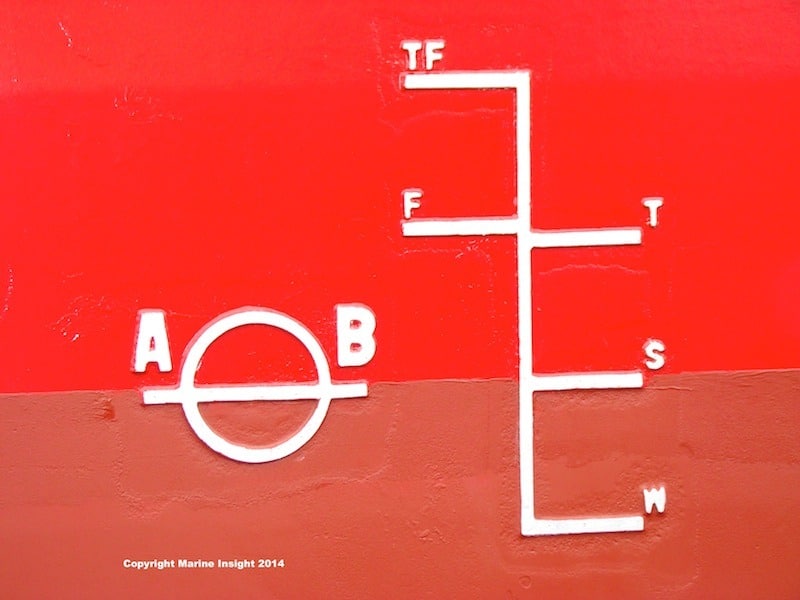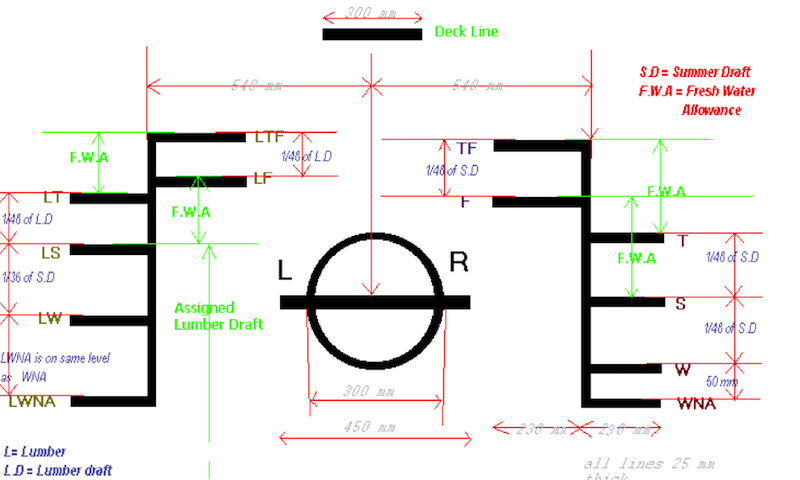

If we try to define Load Line in the simplest fashion, it will be as follows:
“Load line is a special marking positioned amidships which depicts the draft of the vessel and the maximum permitted limit in distinct types of waters to which the ship can be loaded.” When the load line is drawn over the output characteristic curve in a graph, it makes contact at a point known as the operating point/ quiescent point or Q-point.
As a result of the numerous maritime accidents that have happened at sea due to the overloading of vessels, the significance of having a standard maximum limit for ships was identified long before. However, it took many years to have an International agreement for the universal application of Load lines.
It was in 1930 when the first International Load Line Convention took place, after which it was periodically amended until the latest one in 2003.


To make a complete comprehension of Load Lines, we must address the following questions:-
The Load Line concept emerged in Britain in the 1870s to prevent merchant ships from being overloaded. The fundamental purpose of a Load Line is to allow a maximum legal limit up to which a ship can be loaded by cargo. By prescribing such limits, the risk of having the vessel sailing with inadequate freeboard and buoyancy can be limited.
A vessel should have sufficient freeboard at all times. Any exceptions will result in insufficient stability and excessive stress on the ship’s hull. This is where load-lines play an essential role, detecting whether the vessel is overloaded and its freeboard tremendously effortless.
Lloyd’s Register has established a minimum freeboard requirement for its classed ships to ensure their good reserve buoyancy in heavy seas.
However, since the buoyancy and immersion of the vessel largely depend on the type of water and its density, it is not practical to define a standard freeboard limit for the ship at all times. For this reason, the load line convention has put regulations that divide the world into different geographical zones, each having a separate prescribed load line.
For example, A vessel sailing in Winter on North Atlantic Ocean will have a greater freeboard than on a voyage in Tropical Zones and Freshwaters.
As we have already defined above, the Load Line is a special marking positioned amidships. All vessels of 24 meters and more are required to have this Load line marking at the centre position of the length of the summer load waterline.
These marks shall be punched on the hull’s surface, making it visible even if the paint on the side of the ship fades out. The marks shall again be painted white or yellow on a dark background/black on a light background. The complete Load line markings consist of 3 vital parts.
S – Summer:- It is the primary freeboard line at the same level as the Plimsoll Line. Other load lines are marked based on this Summer freeboard line.
T – Tropical:- It is 1/48th of the summer draft marked above the Summer load line.
W – Winter:- It is 1/48th of the summer draft marked below the Summer load line.
WNA – Winter North Atlantic:- It is marked 50mm below the Winter load line. It applies to voyages in North Atlantic ( above 36 degrees of latitude) during the winter months.
F – Fresh Water:- It is the summer freshwater load line. The distance between S and F is the Fresh Water Allowance (FWA).
TF – Tropical Fresh Water is the freshwater load line in Tropical. It is marked above the T at an amount equal to FWA.
Ships engaged in the timber deck cargo trade must have a unique set of Load lines known as the Timber Load Lines. Such vessels shall comply with the Code of Safe Practices for Ships Carrying Timber Deck Cargo in construction and other requirements obtaining greater reserve buoyancy and lesser summer freeboard.


Timber cargo vessels will have a second set of Load Lines marked like the standard load lines positioned 540mm above the centre loading disc.
The timber load line’s letter marking is different and prefixed by ‘L’, meaning ‘Lumber’.
LS – Lumber Summer:- Its upper edge marks the summer saltwater timber loading. It is situated at a specified level above the Plimsol line.
LW – Lumber Winter:- It is 1/36th of the lumber summer draft below LS.
LT – Lumber Tropical:- It is 1/48th of the lumber summer draft above LS.
LWNA – Lumber Winter North Atlantic:- It is at the same level as WNA.
LF – Lumber Freshwater:- It is situated above the LS by an amount equal to FWA.
LTF – Lumber Tropical Fresh Water:- It is positioned above LT by an amount equal to FWA.
Every ship surveyed and marked in accordance with the present Load line convention is issued an International Load Line Certificate by the authorised administration. The certificate will have a validity of not more than five years and will contain all vital information, including the assigned freeboard and freshwater allowance.
It is to be noted that, after completion of a load line survey and issuance of the certificate, no changes shall be made to the superstructure, markings, equipment or arrangements covered under the survey. If such changes need to be made, the survey’s authorised authority shall be contacted.
Over to you.
Please go ahead if you have more points to mention on ship load-lines. We would like to see them as comments!
Also known as the Plimsoll Line, the Load Line is a marking that indicates the extent to which the weight of a load may safely submerge a vessel, by way of a waterline limit.
They are horizontal lines extending forward and aft from a vertical line situated at a distance of 540 mm from the centre of a disc. They measure 230 mm by 23 mm. The upper surface of these lines indicates the maximum depths to which vessels can be submerged in different situations and seasons.
It is the waterline up to which a ship may be loaded in seas during summers when waves are lower and less harsh than in winters.
It is said that a commercial carrier is adequately loaded when its waterline is equal to the plimsoll line which is located on the hull of a ship.
There are two types of load line markings. The standard load line marking is applicable to all vessels and the Timber load line markings are for ships carrying timber.
You might also like to read
Disclaimer: The authors’ views expressed in this article do not necessarily reflect the views of The Marine Learners. Data and charts, if used in the article, have been sourced from available information and have not been authenticated by any statutory authority. The author and The Marine Learners do not claim it to be accurate nor accept any responsibility for the same. The views constitute only the opinions and do not constitute any guidelines or recommendations on any course of action to be followed by the reader.
The article or images cannot be reproduced, copied, shared or used in any form without the permission of the author and The Marine Learners.










We believe that knowledge is power, and we’re committed to empowering our readers with the information and resources they need to succeed in the merchant navy industry.
Whether you’re looking for advice on career planning, news and analysis, or just want to connect with other aspiring merchant navy applicants, The Marine Learners is the place to be.